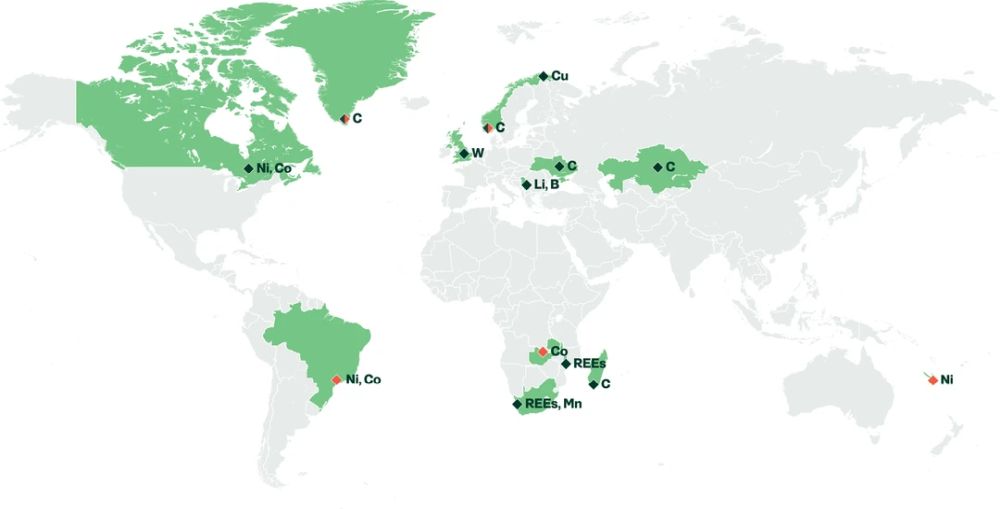- within Government and Public Sector topic(s)
- within Insurance, Real Estate and Construction and Consumer Protection topic(s)
Following the commission's announcement in March of the first 47 Strategic Projects under the EU Critical Raw Materials Act (Act) located within the EU (discussed in our previous article, the commission has confirmed 13 Strategic Projects located outside of the EU.
This initiative complements the earlier announcement, with all 60 projects expected to contribute to the EU's critical minerals value chain. By designating non-EU projects as Strategic Projects, the EU is hoping to enhance investment opportunities and financing, even without directly accelerating permitting and development over which EU does not have control. This step reflects the EU's strategy of securing critical material supplies through partnerships with third countries as well as developing local supply chains, even if these projects could technically be in competition with EU projects for investment.
Selection of the non-EU Strategic Projects was made by the commission via a separate selection process to the initial within the EU list. Like the EU Strategic Projects, these projects were selected based on technical feasibility and criteria under the act. They needed to be mutually beneficial to both the EU and the third countries involved and contribute to EU supply security.
Announced on June 4, 2025, the 13 non-EU Strategic Projects are in Brazil, Canada, Greenland, Kazakhstan, Madagascar, Malawi, New Caledonia, Serbia, South Africa, Ukraine, United Kingdom, and Zambia. The commission has also released a list of all of the Strategic Projects and their strategic raw materials. All projects focus on the materials needed for clean energy, transport, defense, and aerospace sectors.
Building resilience in the European battery value chain continues to be a focus of the new announcement with ten of the projects focusing on critical battery materials such as lithium, nickel, cobalt, manganese, and graphite. Two projects, one in South Africa and the other in Malawi, involve the extraction of rare earth elements (REEs), which are important in producing high-performance magnets used in electric vehicles, certain renewable energy technologies and other applications.

Significance of Strategic Projects outside the EU
The selected Strategic Projects will receive coordinated support from the commission and EU member states and financial institutions. This support includes measures to facilitate project financing, such as providing advice on the availability of assistance from the European Investment Bank Group and member states' export credit agencies, as well as guidance on accessing applicable EU financing programs. The commission estimates that the 13 projects will require an investment of EUR5.5 billion to commence. Additionally, developers of external Strategic Projects may benefit from the EU system being designed by the commission to enable agreements between developers and European off takers.
In our previous article, we flagged the EU's challenge in meeting its 10% extraction target for raw strategic materials by 2030. Its acknowledged lack of domestic supplies of raw strategic materials is one of the stated reasons behind the act. The REE extraction projects are a good example of why the EU needs Strategic Projects within and outside the EU, with the outside the EU projects key to filling "gaps" in the EU's available natural resources. Due to limited domestic supplies, the EU relies highly on third-country REE sources, with EU demand for REEs expected to increase fivefold by 2030 compared to 2020.1The additional non-EU REE Strategic Projects aim to secure EU's supply, complementing three EU based projects focusing on REE processing.
Of course, the importance of securing supplies of REEs has been underscored recently by ongoing U.S.-China trade disputes. In its recent Global Critical Minerals Outlook 2025, the International Energy Agency (IEA) indicated that while REEs are expected to be sufficiently supplied in 2035 based on the global project pipeline, their concentration (and the concentration of graphite) remains a key vulnerability for western countries.2
The commission is also working to strengthen trade relationships with third countries where the EU already has agreements on critical materials. Of the 13 projects, seven are in countries that have Strategic Partnerships with the EU, aligning with the EU's strategy to diversify sourcing, reduce dependencies, and promote sustainable development in partner third countries.
Given recent strains in transatlantic trade relations and China's significant role in many key raw material value chains, the EU appears focused on investing additional resources in extending its approach of prioritizing partnerships to diversify supply chains, with renewed emphasis on defense as well as clean energy.
Next steps
Clients in this sector can expect additional developments. Further announcements from the commission on Strategic Projects are anticipated in due course. Meanwhile, the UK government has confirmed that its revised critical minerals strategy will be revealed this summer. Considering the likely reset of the government's approach, it is expected to be influenced by the ongoing global trade uncertainties and to provide an indication of its plans to strengthen the UK's position in critical minerals production.
Footnotes
1. webgate.ec.europa.eu/circabc-ewpp/d/d/workspace/SpacesStore/980c7927-6ab8-42e5-a288-9b9cd500c6e0/download
2. www.iea.org/reports/global-critical-minerals-outlook-2025/overview-of-outlook-for-key-minerals
The content of this article is intended to provide a general guide to the subject matter. Specialist advice should be sought about your specific circumstances.







